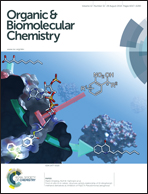Balanced π–π interactions directing the self-assembly of indolocarbazole-based low molecular mass organogelators†
Abstract
New indolocarbazole derivatives emitting strong blue light have been synthesized. It is found that the strong π–π interactions between indolocarbazoles 4–6 without long carbon chains lead to the formation of crystal or crystal-like aggregates. We have previously found that tert-butyl could tune the strength of π–π interactions between carbazole units and the organogels were obtained from tert-butyl substituted carbazoles directed by balanced π–π interactions. Herein, hexadecyl groups were introduced into N-positions of indolocarbazoles in order to reduce the strength of π–π interactions between indolocarbazoles, and compounds 7–9 were prepared. It is interesting that compounds 8 and 9 could form stable organogels in alcohols, acetone, DMSO, and so on, upon ultrasound stimulation. Combined with the results of electronic spectra, XRD patterns and the optimized molecular length based on the semiempirical (AM1) calculations, we suggested the molecular packing modes in gel states, in which the lamellar structures were involved. Although the fluorescence emission of indolocarbazoles 8 and 9 decreased during the gel formation to some extent, the obtained gel nanofibers still emitted strong blue light and the fluorescence emission of the film based on xerogel 9 decreased significantly upon exposure to gaseous TNT. It meant that the xerogels based on indolocarbazoles could be used as fluorescent sensors for detecting vapors of explosives.


 Please wait while we load your content...
Please wait while we load your content...